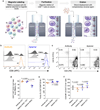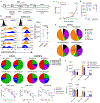Traceless aptamer-mediated isolation of CD8+ T cells for chimeric antigen receptor T-cell therapy
- PMID: 31209354
- PMCID: PMC6783348
- DOI: 10.1038/s41551-019-0411-6
Traceless aptamer-mediated isolation of CD8+ T cells for chimeric antigen receptor T-cell therapy
Abstract
Chimeric antigen receptor T-cell therapies using defined product compositions require high-purity T-cell isolation systems that, unlike immunomagnetic positive enrichment, are inexpensive and leave no trace on the final cell product. Here, we show that DNA aptamers (generated with a modified cell-SELEX procedure to display low-nanomolar affinity for the T-cell marker CD8) enable the traceless isolation of pure CD8+ T cells at low cost and high yield. Captured CD8+ T cells are released label-free by complementary oligonucleotides that undergo toehold-mediated strand displacement with the aptamer. We also show that chimeric antigen receptor T cells manufactured from these cells are comparable to antibody-isolated chimeric antigen receptor T cells in proliferation, phenotype, effector function and antitumour activity in a mouse model of B-cell lymphoma. By employing multiple aptamers and the corresponding complementary oligonucleotides, aptamer-mediated cell selection could enable the fully synthetic, sequential and traceless isolation of desired lymphocyte subsets from a single system.
Figures






References
Publication types
MeSH terms
Substances
Grants and funding
LinkOut - more resources
Full Text Sources
Other Literature Sources
Molecular Biology Databases
Research Materials

